
Tenochtitlan, also known as Mexico-Tenochtitlan, was a large Mexican altepetl in what is now the historic center of Mexico City. The exact date of the founding of the city is unclear. The date 13 March 1325 was chosen in 1925 to celebrate the 600th anniversary of the city. The city was built on an island in what was then Lake Texcoco in the Valley of Mexico. The city was the capital of the expanding Aztec Empire in the 15th century until it was captured by the Spanish in 1521.

Aztec mythology is the body or collection of myths of the Aztec civilization of Central Mexico. The Aztecs were Nahuatl-speaking groups living in central Mexico and much of their mythology is similar to that of other Mesoamerican cultures. According to legend, the various groups who were to become the Aztecs arrived from the north into the Anahuac valley around Lake Texcoco. The location of this valley and lake of destination is clear – it is the heart of modern Mexico City – but little can be known with certainty about the origin of the Aztec. There are different accounts of their origin. In the myth the ancestors of the Mexica/Aztec came from a place in the north called Aztlan, the last of seven nahuatlacas to make the journey southward, hence their name "Azteca." Other accounts cite their origin in Chicomoztoc, "the place of the seven caves," or at Tamoanchan.

The Aztecs were a Mesoamerican culture that flourished in central Mexico in the post-classic period from 1300 to 1521. The Aztec people included different ethnic groups of central Mexico, particularly those groups who spoke the Nahuatl language and who dominated large parts of Mesoamerica from the 14th to the 16th centuries. Aztec culture was organized into city-states (altepetl), some of which joined to form alliances, political confederations, or empires. The Aztec Empire was a confederation of three city-states established in 1427: Tenochtitlan, city-state of the Mexica or Tenochca; Texcoco; and Tlacopan, previously part of the Tepanec empire, whose dominant power was Azcapotzalco. Although the term Aztecs is often narrowly restricted to the Mexica of Tenochtitlan, it is also broadly used to refer to Nahua polities or peoples of central Mexico in the prehispanic era, as well as the Spanish colonial era (1521–1821). The definitions of Aztec and Aztecs have long been the topic of scholarly discussion ever since German scientist Alexander von Humboldt established its common usage in the early 19th century.
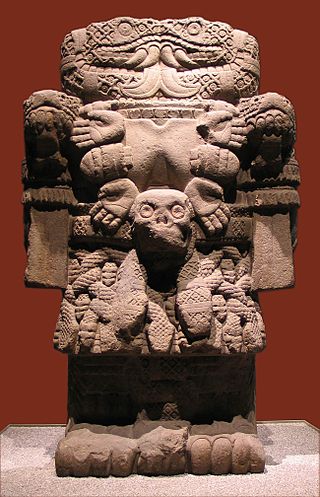
Coatlicue, wife of Mixcōhuātl, also known as Tēteoh īnnān, is the Aztec goddess who gave birth to the moon, stars, and Huītzilōpōchtli, the god of the sun and war. The goddesses Toci “our grandmother” and Cihuacōātl “snake woman”, the patron of women who die in childbirth, were also seen as aspects of Cōātlīcue.
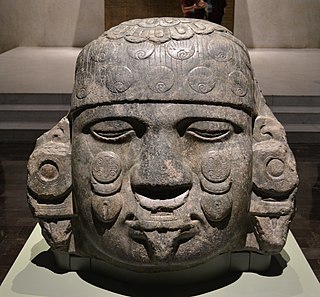
In Aztec religion, Coyolxāuhqui is a daughter of the priestess Cōātlīcue. She was the leader of her brothers, the Centzon Huitznahua. She led her brothers in an attack against their mother, Cōātlīcue, when they learned she was pregnant, convinced she dishonored them all. The attack is thwarted by Coyolxāuhqui's other brother, Huitzilopochtli, the national deity of the Mexicas.

In Aztec mythology, Huitzilopochtli is the deity of war, sun, human sacrifice, and the patron of the city of Tenochtitlan. He was also the tribal god of the Mexicas, also known as the Aztecs, of Tenochtitlan. Many in the pantheon of deities of the Aztecs were inclined to have a fondness for a particular aspect of warfare. However, Huitzilopochtli was known as the primary god of war in ancient Mexico. Since he was the patron god of the Mexica, he was credited with both the victories and defeats that the Mexica people had on the battlefield. The people had to make sacrifices to him to protect the Aztec from infinite night. He wielded Xiuhcoatl, the fire serpent, as a weapon, thus also associating Huitzilopochtli with fire.

In Aztec mythology, Malinalxochitl, or Malīnalxōch, was a sorceress and goddess of snakes, scorpions, and insects of the desert. She claimed the title Cihuacoatl, meaning "Woman Serpent" or "Snake Woman". Her brother was Huītzilōpōchtli. During the migration, she was abandoned during her sleep by the Mexicas as directed by her brother. Afterward she had a son named Copil with Chimalcuauhtli, king of Malinalco.
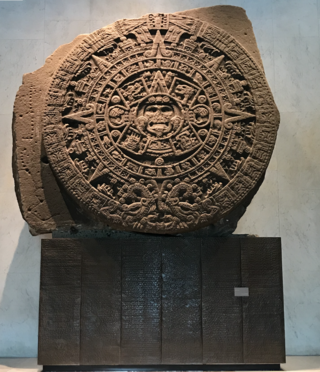
The Aztec or Mexica calendar is the calendrical system used by the Aztecs as well as other Pre-Columbian peoples of central Mexico. It is one of the Mesoamerican calendars, sharing the basic structure of calendars from throughout ancient Mesoamerica.
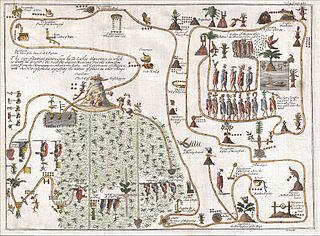
Aztlán is the ancestral home of the Aztec peoples. Astekah is the Nahuatl word for "people from Aztlan". Aztlan is mentioned in several ethnohistorical sources dating from the colonial period, and while they each cite varying lists of the different tribal groups who participated in the migration from Aztlan to central Mexico, the Mexica who went on to found Mexico-Tenochtitlan are mentioned in all of the accounts.
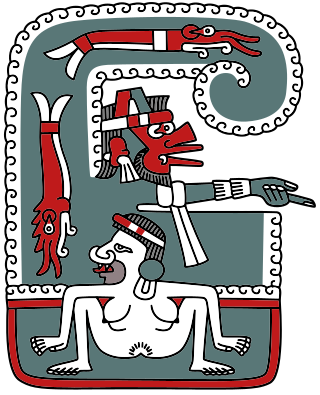
Chimalman or Chīmalmā /t͡ʃiːmalmaː/ is a goddess in Aztec mythology, and was considered by the Aztecs to be the mother of the Toltec god Quetzalcoatl. Her name means "shield-hand."

Tlacaelel I was the principal architect of the Aztec Triple Alliance and hence the Mexica (Aztec) empire. He was the son of Emperor Huitzilihuitl and Queen Cacamacihuatl, nephew of Emperor Itzcoatl, father of poet Macuilxochitzin, and brother of Emperors Chimalpopoca and Moctezuma I.

The Aztec Empire or the Triple Alliance was an alliance of three Nahua city-states: Mexico-Tenochtitlan, Tetzcoco, and Tlacopan. These three city-states ruled that area in and around the Valley of Mexico from 1428 until the combined forces of the Spanish conquistadores and their native allies who ruled under Hernán Cortés defeated them in 1521.

The Aztec religion is a monistic pantheism in which the Nahua concept of teotl was construed as the supreme god Ometeotl, as well as a diverse pantheon of lesser gods and manifestations of nature. The popular religion tended to embrace the mythological and polytheistic aspects, and the Aztec Empire's state religion sponsored both the monism of the upper classes and the popular heterodoxies.

The Aztecs were a Pre-Columbian Mesoamerican people of central Mexico in the 14th, 15th, and 16th centuries. They called themselves Mēxihcah.

Codex Boturini, also known as the Tira de la Peregrinación de los Mexica, is an Aztec codex, which depicts the migration of the Azteca, later Mexica, people from Aztlán. Its date of manufacture is unknown, but likely to have occurred before or just after the Conquest of the Aztec Empire. At least two other Aztec codices have been influenced by the content and style of the Boturini Codex. This Codex has become an insignia of Mexica history and pilgrimage and is carved into a stone wall at the entrance of the National Museum of Anthropology and History in Mexico City.

The Codex Azcatitlan is an Aztec codex detailing the history of the Mexica and their migration journey from Aztlán to the Spanish conquest of the Aztec Empire. The exact date when the codex was produced is unknown, but scholars speculate it was crafted some time between the mid-16th and 17th centuries. The name of this important Mexica pictorial manuscript was suggested by its first editor, Robert H. Barlow, who erroneously interpreted the anthill on page 2 as the glyph for “Aztlán.” In the Bibliothèque nationale de France, where it is housed, it is known as Histoire mexicaine, [Manuscrit] Mexicain 59–64.

The Mexica were a Nahuatl-speaking indigenous people of the Valley of Mexico who were the rulers of the Aztec Empire. The Mexica established Tenochtitlan, a settlement on an island in Lake Texcoco, in 1325. A dissident group in Tenochtitlan separated and founded the settlement of Tlatelolco with its own dynastic lineage. In 1521, they were conquered by an alliance of Spanish conquistadors and indigenous people including the Tlaxcaltecs led by Hernán Cortés.

The Coyolxāuhqui Stone is a carved, circular Aztec stone, depicting the mythical being Coyolxāuhqui ("Bells-Her-Cheeks"), in a state of dismemberment and decapitation by her brother, the patron deity of the Aztecs, Huitzilopochtli. It was rediscovered in 1978 at the site of the Templo Mayor of Tenochtitlan, now in Mexico City. This relief is one of the best known Aztec monuments and one of the few great Aztec monuments that have been found fully in situ.

Cuauhtlequetzqui or Cuauhtliquetzqui is an Aztec name meaning rising eagle and used by several historical people.

The coat of arms of Mexico depicts a Mexican (golden) eagle perched on a prickly pear cactus devouring a rattlesnake. The design is rooted in the legend that the Aztec people would know where to build their city once they saw an eagle eating a snake on top of a lake. The image has been an important symbol of Mexican politics and culture for centuries. To the people of Tenochtitlan, this symbol had strong religious connotations, and to the Europeans, it came to symbolize the triumph of good over evil.



















